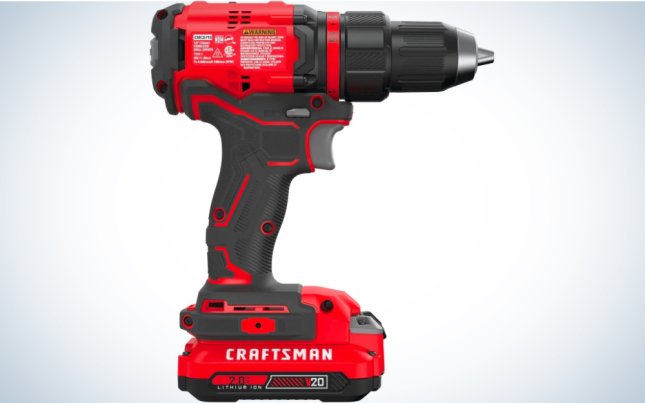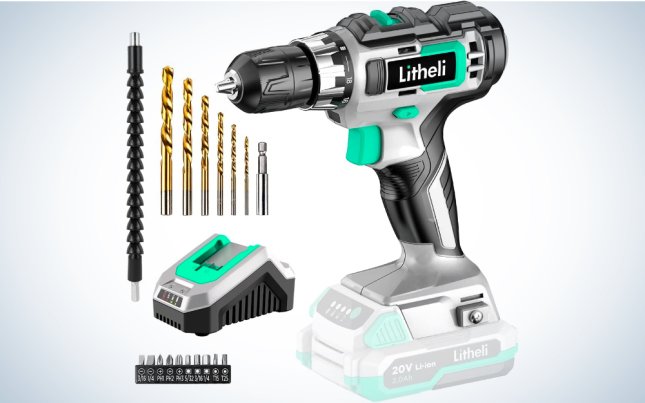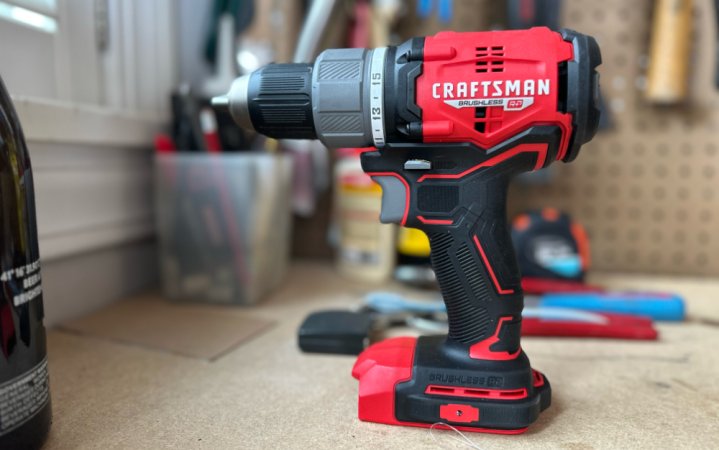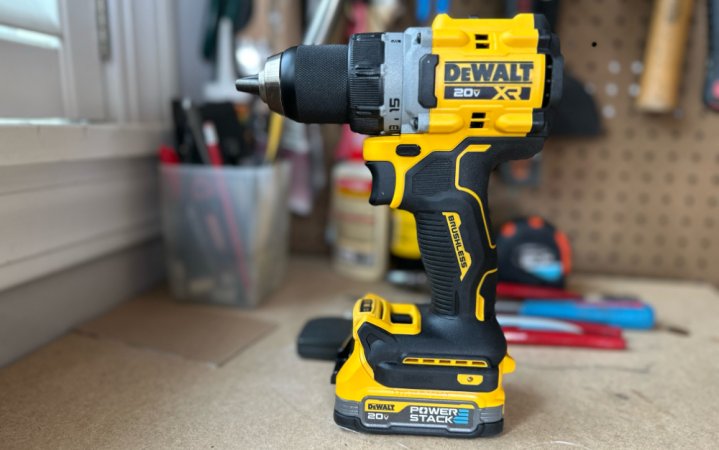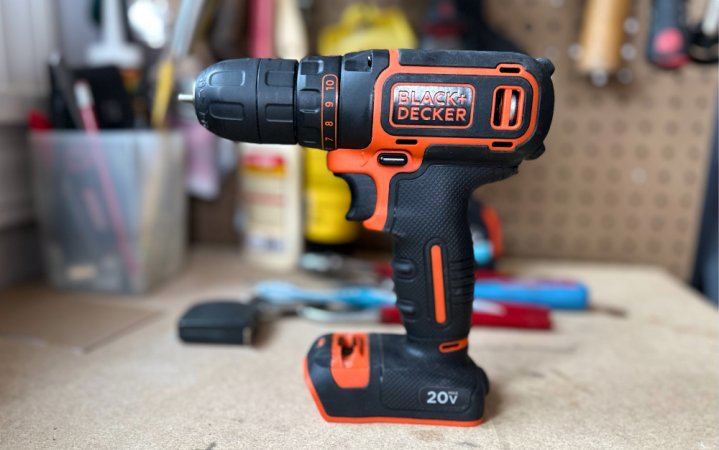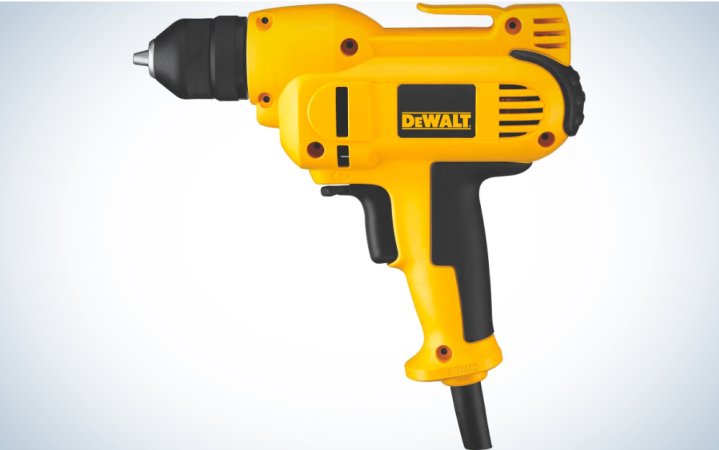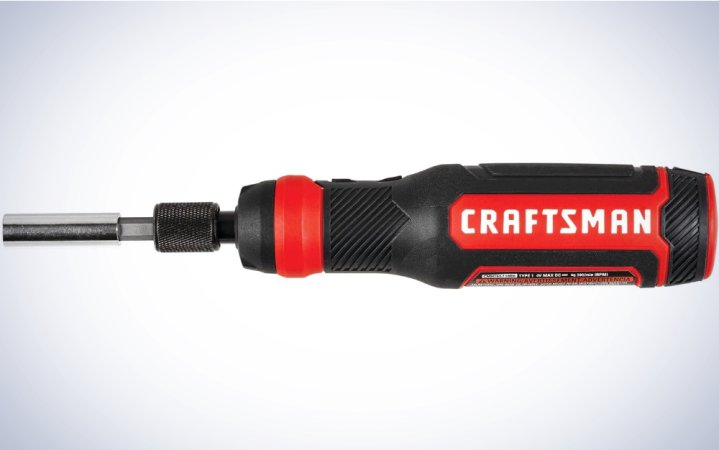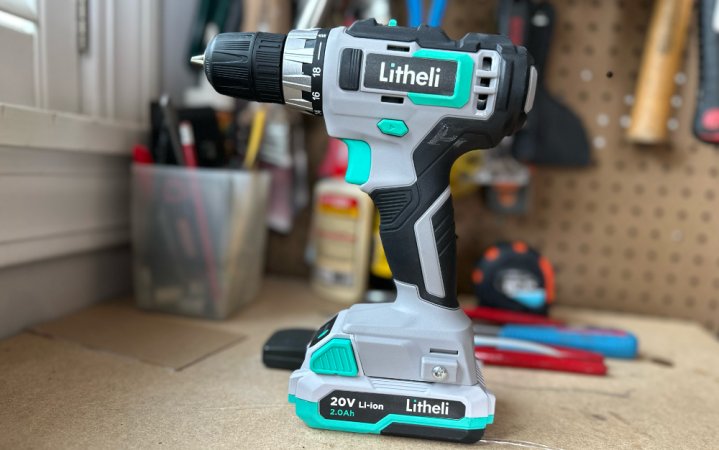We may earn revenue from the products available on this page and participate in affiliate programs. Learn more ›
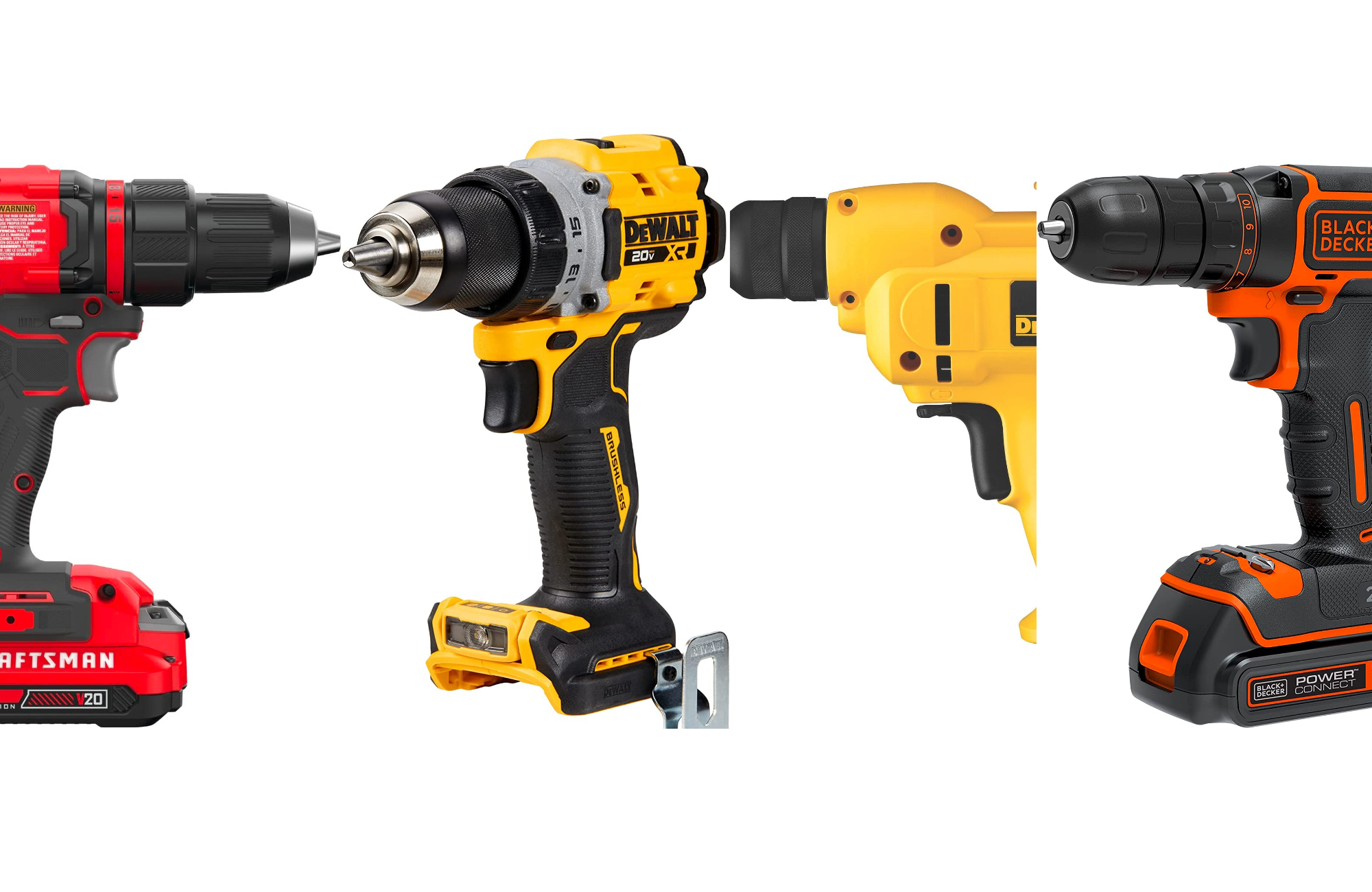
A power drill is one of the few tools that belong in every tool room (if you’re lucky enough to have the space) or closet shelf. Their one job—inserting and removing screws—is extremely common in DIY projects and home repair. In some cases, you can get the same job done with a screwdriver, but a power drill like our best overall, the Craftsman V20 cordless, speeds up the process significantly. This is especially helpful if you’re working on a larger project with many screws. Other projects, like installing the wall mount for your TV, or getting screws through metal sheets, require a power tool. The best power drills will help you get your home projects done more quickly and efficiently, no matter how big or small.
- Best overall: CRAFTSMAN CMCD710C2
- Best cordless power drill: DeWalt DCD800B
- Best lightweight: BLACK+DECKER BDCDD120C
- Best corded: DeWalt DWD115K
- Best electric screwdriver: CRAFTSMAN CMHT66718B20
- Best budget: Litheli Cordless Drill
How we chose the best power drills
A majority of our recommendations for the best power drills come from hands-on testing. We used drills to assemble furniture, wall-mount a TV, and perform other common tasks like tightening screws on cabinet handles and modular chairs. Some of these tasks could have been accomplished with a screwdriver, but using a power drill cut the time they took significantly. The conclusion after our tests was that a power drill is an essential tool, and you don’t have to spend a tremendous amount of money to get a good one.
The best power drills: Reviews & Recommendations
Selecting the right power drill for you comes down to the types of jobs you want to do. All of our recommendations allow you to insert and remove screws when assembling furniture successfully, but you’ll want a more powerful model if you’re working with metal. Additionally, you’ll have to decide whether you’d like a corded or cordless drill. See if the company offers optional accessories you can pick up down the line to increase your productivity. Finally, be sure to get a power drill within your budget—there’s no need to splurge unnecessarily.
Best overall: Craftsman CMCD710C2
Pros
- Extremely powerful
- Relatively quiet at maximum speed
- Can be used with any materials
Cons
- Heavy
- Price
Specs
- Drill power: 3,400 RPM
- Weight: 5.6 pounds
- Price: $129
We could tell the quality of Craftsman’s CMCD710C2 from the moment we took it out of its packaging, and our expectations were exceeded the first time we used it for a project. It drove screws through plaster and a wooden beam during a TV wall-mounting project like a hot knife running through butter. The process went so smoothly that we initially thought we’d missed the beam until the tell-tale sound of a screw going through wood began.
This was the most powerful power drill we tested but also the heaviest. In theory, getting the job done more quickly means your wrists and arms shouldn’t get fatigued as easily. That was our experience, but it may not always be the case. One unexpected feature of the CMCD710C2 was that it was relatively quiet, even at full speed. Despite its increased power, it made roughly the same amount of noise as other drills we tested—if not a little less.
There’s no technical downside to using this power drill beyond its weight, but you should also consider its price. The CMCD710C2 is over four times as expensive as our budget recommendation, though it does come with a battery and charger. If you want the absolute best performance from a power drill and to be safe in knowing you’ll never need to upgrade again, this is the one to get.
Best cordless power drill: DeWalt DCD800B
Pros
- Great balance of power and weight
- Excellent accessory ecosystem
- Compact design
Cons
- Price
Specs
- Drill power: 2,000 RPM
- Weight: 3.1 pounds
- Price: $159
DeWalt’s DCD800B offers an excellent balance of performance and price in a slightly more compact package, but the company’s accessory ecosystem propels it ahead of the competition. This power drill could handle any task we threw at it, from assembling furniture to driving screws through the tops of storage bins to keep them secure during a move. While it’s not as powerful as our top recommendation, we never felt as though we were held back from doing any task.
We also tested DeWalt’s USB-C charging kit, which was a game-changer. Charging a drill’s battery using a common cable and power adapter (DeWalt includes both in the kit) was great. If its cable or power adapter broke (unlikely as they’re both well constructed), those pieces could be replaced while the actual charger could continue to be used.
One feature that crept up on us during our testing was the DCD800 B’s slightly more compact body, which made it a little easier to use in tighter spots. We didn’t notice the difference at first, but it was apparent when comparing this power drill to other models we tested. It’s a little pricer than many of our other recommendations, but there’s more than enough here to justify the DCD800B as the best splurge.
Best lightweight: BLACK+DECKER BDCDD120C
Pros
- Extremely light
- Easy to control
- Built-in LED
Cons
- Slow maximum speed
Specs
- Drill power: 650 RPM
- Weight: 2.5 pounds
- Price: $59
BLACK+DECKER’s BDCDD120C has been our go-to power drill for several years, and its lightweight and modest price makes it the ideal choice for beginners with modest needs. The star of the show here is how easy this battery-operated drill is to use, thanks to its weight. If you have weaker wrists or arms, picking up the BDCDD120C is a no-brainer. The weight reduction comes down to the materials BLACK+DECKER used and its less powerful motor.
We could still get common tasks like tightening screws on dressed and drawer handles done in no time flat, but wall mounting a TV a couple of years back was more of a struggle. Yes, this drill got the job done, but it took a little more time and effort than it would’ve on a more robust model. On the upside, the drill has a battery, charger, and double-sided bit, so you can start using it right out of the box. We appreciate that because it makes the BDCDD120C even easier to recommend to beginners.
If you typically need a power drill to expedite the process of assembling furniture or take on a larger DIY or home repair project once or twice a year, BLACK+DECKER’s BDCDD120C is your best value and all you’ll need.
Best corded: DeWalt DWD115K
Pros
- High speed
- Similar specs to cordless versions
- No need to worry about battery life
Cons
- Need to be tethered to an outlet
Specs
- Drill power: 2,500 RPM
- Weight: 4.4 pounds
- Price: $89
This corded drill set from DeWalt shares many of the great features we liked about the cordless model we tested—but you never have to worry about it running out of juice. In fact, this power drill’s maximum speed is 25% faster than its cordless cousin. That said, carrying a cable around comes with one big downside: using it means you’re literally being tied to an outlet. Plus, while the drill itself isn’t heavy, you’ll also be carrying the weight of its cord around you everywhere.
On the upside, this drill continues the tradition of DeWalt choosing a svelter shape to make it a little easier to get into tight spaces. This drill’s design, coupled with its additional power, will be useful if you need to drill through a particularly hard surface. You’ll also be safe in knowing the drill can run at its top speed indefinitely because DeWalt didn’t have to worry about battery life when designing it. If you understand the inherent tradeoff in choosing a corded drill over a cordless one, this set from DeWalt is a fantastic choice.
Best electric screwdriver: CRAFTSMAN CMHT66718B20
Pros
- Portability
- USB rechargeable
- Price
Cons
- Not as powerful
Specs
- Drill power: 300 RPM
- Weight: 4.4 pounds
- Price: $41
If your drilling needs are modest, you may be able to get away with using an electric screwdriver instead. Craftsman’s CMHT66718B20 may look like a typical screwdriver, but at the push of a button it can spin a bit up to 300 rotations per minute. In our tests this electric screwdriver was easy to hold, and powerful enough to help us install smart locks into door frames and smoke detectors through drywall. We could hear the screwdriver struggle while trying to drive screws through solid wood, which is the type of job that requires a power drill.
One of this electric screwdriver’s best features is its built-in battery, which gets recharged by plugging the included MicroUSB to USB-A cable into a power adapter. It’s a shame Craftsman didn’t update this electric screwdriver with the now-ubiquidous USB-C port, but hope that revision is in the works. As it stands, this electric screwdriver was easy to charge and lasted long enough to complete a few jobs before needing to be recharged. If you find yourself using this tool frequently, you may need to plug it in every couple of days. An electric screwdriver can’t compete with a power drill at every task, but the CMHT66718B20 is perfectly suitable for making smaller DIY projects faster and less fatiguing to complete.
Best budget: Litheli Cordless Drill
Pros
- Comes with accessories
- Feels surprisingly solid
- Price
Cons
- Lower maximum speed
Specs
- Drill power: 1,300 RPM
- Weight: 3.5 pounds
- Price: $59.99
Litheli bucked the trend of pricey power tools with its feature-competitive-yet-cost-effective power drill, which it bundles with 10 drivers. At $30 on average, you wouldn’t expect to get much performance from this power drill, yet it continually came through for us in our tests. It felt a little less luxe than the other drills we tested, but never like a toy or second-rate tool limited by its price.
We tested this cordless drill set like we put DeWalt’s cordless model through its paces: driving screws through boxes and tightening screws on the back of drawers. It performed very well in these tests, and the different bits included meant we always had the right-sized one for the screw we were using. Despite being middle-of-the-road power-wise, we didn’t feel restricted by using this drill, which will be sufficient for all but the most intense projects.
This drill doesn’t come with a battery or charger; you’ll need to pick them up separately. You’d expect this to inflate the power drill’s cost, but Litheli offers a set with those accessories for $50. And, at the time of this writing, Amazon has been known to offer coupons that bring the price down up to 20%—at that price, it’s a steal. If you’ve put off getting a power drill because of its cost, Litheli gives you no excuse.
What to consider when choosing the best power drill for you
Power drills come in various configurations, and the one that’s right for you will depend on how you plan on using it. Below are the technical features and other factors we considered most important when selecting the power drills we tested. One of our overarching goals was to provide recommendations across a broad range of price ranges, so entry-level DIYers and semi-professionals alike would be satisfied.
Drill power
There are many ways to determine the power level of a drill, but we opted to highlight its maximum rotations per minute—shortened to RPM. This is a less abstract unit of measurement than a power drill’s energy draw, measured in volts. The bottom line is that the faster a drill can spin, the faster you can get your job done.
Weight
Many of the power drills we’ve tested for this guide are cordless, which means the weight is a critical factor in determining the one to get. Our recommendations weigh less than six pounds, which is relatively light for a power tool. You may feel some wrist or arm strain after holding a power drill for extended periods, but that issue can be alleviated by holding it with two hands. This may not be possible with every job, but using both hands has the added benefit of allowing you to hold the power drill more steadily.
Accessories
For most people, a power drill is a one-time purchase since there’s very little reason to upgrade once you have a model you like. That said, most companies offer optional accessories—bit sets, higher-capacity batteries, USB-C chargers—you can pick up over time to improve the drill’s experience. In some cases, common accessories like bits and cases don’t have to come from the same manufacturer as your power drill, but that’s not always true.
FAQs
This depends on the types of jobs you plan on using it for. If your needs are basic, our best budget pick will suit you just fine. If you’re routinely driving thick screws through sheets of metal, jump up to a more powerful model.
If you’re working on something delicate—like opening an electronic device to perform a repair—a power drill may be overkill, and you risk stripping its screws or damaging the device. In that case, we recommend using a screwdriver instead.
Most electric drills are cordless, and they offer the same level of performance as corded models. You’ll have to make the tradeoff between portability and keeping batteries charged vs. unlimited battery life but literally being tethered to an outlet.
This depends on its power level and the materials used to make it. Our power drill recommendations range from $30 to roughly $150. Keep in mind this is the cost of the drill on its own, and the price will be inflated once you pick up accessories like a case or battery.
Final thoughts on choosing the best power drill set for you
- Best overall: CRAFTSMAN CMCD710C2
- Best cordless power drill: DeWalt DCD800B
- Best lightweight: BLACK+DECKER BDCDD120C
- Best corded: DeWalt DWD115K
- Best electric screwdriver: CRAFTSMAN CMHT66718B20
- Best budget: Litheli Cordless Drill
At the end of the day, any power drill you choose will be more effective in most situations than a screwdriver, and most will run you less than $100. It’s well worth investing in a tool you will use for several years—if not the rest of your life—that’s guaranteed to save you time. A power drill can make intimidating projects seem more reasonable and may even encourage you to take on smaller home repairs yourself rather than paying a professional to do it for you. If you’re picking up your first set of power tools, a power drill is the first one we recommend. It has the most utility for common tasks, and you may be surprised by how often you pick it up.
